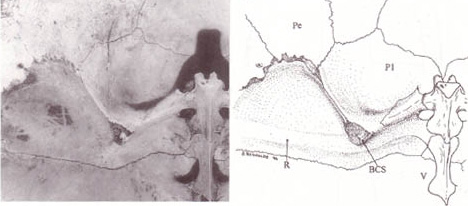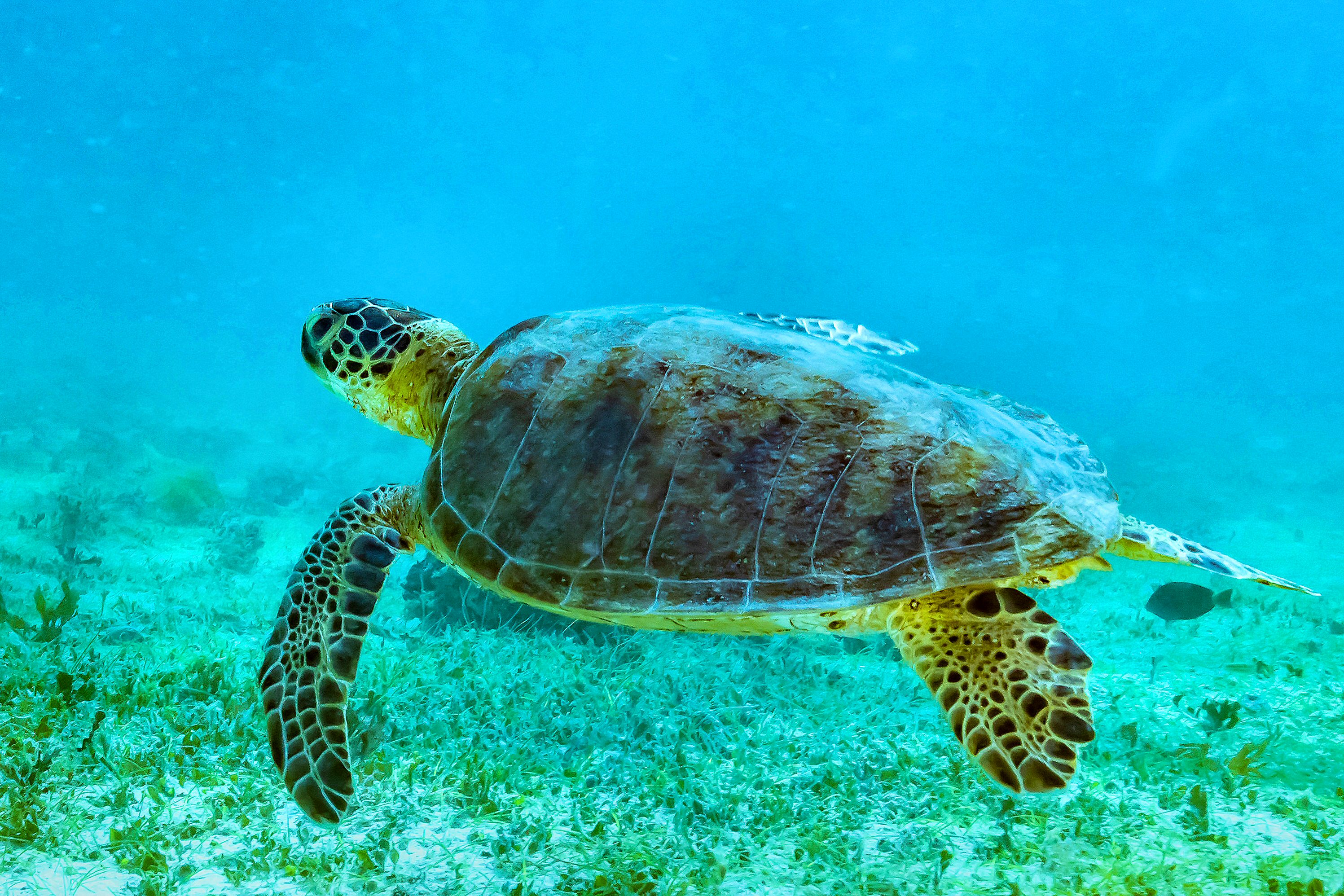|
Odontochelys
''Odontochelys semitestacea'' (meaning "toothed turtle with a half-shell") is a Late Triassic relative of turtles. Before ''Pappochelys'' was discovered and ''Eunotosaurus'' was redescribed, ''Odontochelys'' was considered the oldest undisputed member of Pantestudines (i.e. a stem-turtle). It is the only known species in the genus ''Odontochelys'' and the family Odontochelyidae. Discovery ''Odontochelys semitestacea'' was first described from three 220-million-year-old specimens excavated in Triassic deposits in Guizhou, China. The locale of its discovery at one time was the Nanpanjiang Trough basin, a shallow marine environment surrounded on three sides by land. These deposits preserve an ecosystem known as the Guanling biota, which was dominated by marine reptiles. Description ''Odontochelys'' differed grossly from modern turtles. Modern turtles have a horny beak without teeth in their mouth. In contrast, ''Odontochelys'' fossils were found to have had teeth embedded in thei ... [...More Info...] [...Related Items...] OR: [Wikipedia] [Google] [Baidu] |
Pappochelys
''Pappochelys'' ( meaning "grandfather turtle" in Greek) is an extinct genus of diapsid reptile possibly related to turtles. The genus contains only one species, ''Pappochelys rosinae'', from the Middle Triassic of Germany, which was named by paleontologists and Hans-Dieter Sues in 2015. The discovery of ''Pappochelys'' provides strong support for the placement of turtles within Diapsida, a hypothesis that has long been suggested by molecular data, but never previously by the fossil record. It is morphologically intermediate between the definite stem-turtle '' Odontochelys'' from the Late Triassic of China and ''Eunotosaurus'', a reptile from the Middle Permian of South Africa. Description ''Pappochelys'' had a wide body, small skull, and a long tail that makes up about half of the total body length, which is up to . The skull is pointed with large eye sockets. Several turtle-like features are present, including expanded ribs and gastralia that seem to be precursors of a shel ... [...More Info...] [...Related Items...] OR: [Wikipedia] [Google] [Baidu] |
Pantestudines
Pantestudines or Pan-Testudines is the proposed group of all Reptile, reptiles more closely related to turtles than to any other living animal. It includes both modern turtles (crown group turtles, also known as Testudines) and all of their extinct relatives (also known as Stem-group, stem-turtles). Pantestudines with a complete shell are placed in the clade Testudinata. Classification The identity of the ancestors and closest relatives of the turtle lineage was a longstanding scientific mystery, though new discoveries and better analyses in the early 21st century began to clarify turtle relationships. They had frequently been considered relatives of the Captorhinidae, captorhinids, which also possessed an anapsid skull configuration. Later, the consensus shifted towards Testudinata's placement within Parareptilia, another "anapsid" clade. Analysis of fossil data has shown that turtles are likely diapsid reptiles, most closely related either to the archosaurs (crocodiles, bird, a ... [...More Info...] [...Related Items...] OR: [Wikipedia] [Google] [Baidu] |
Plastron
The turtle shell is a shield for the ventral and dorsal parts of turtles (the Order (biology), order Testudines), completely enclosing all the turtle's vital organs and in some cases even the head. It is constructed of modified bony elements such as the ribs, parts of the pelvis and other bones found in most reptiles. The bone of the shell consists of both skeletal and dermal bone, showing that the complete enclosure of the shell likely evolved by including dermal armor into the rib cage. The turtle's shell is an important study, not just because of the apparent protection it provides for the animal but also as an identification tool, in particular with fossils, as the shell is one of the likely parts of a turtle to survive fossilization. Hence understanding the shell structure in living species provides comparable material with fossils. The shell of the hawksbill turtle, among other species, has been used as a material for a wide range of small decorative and practical items sin ... [...More Info...] [...Related Items...] OR: [Wikipedia] [Google] [Baidu] |
Eunotosaurus
''Eunotosaurus'' (''Latin (language), Latin'': Stout-backed lizard) is an extinct genus of amniote, possibly a close relative of turtles. ''Eunotosaurus'' lived in the late Middle Permian (Capitanian stage) and fossils can be found in the Karoo Supergroup of South Africa and Malawi. ''Eunotosaurus'' resided in the swamps of what is now southern Africa. Its ribs were wide and flat, forming broad plates similar to a primitive turtle shell, and the vertebrae were nearly identical to those of some turtles. Accordingly, it is often considered as a possible transitional fossil between turtles and their prehistoric ancestors. However, it is possible that these turtle-like features evolved independently of the same features in turtles, since other anatomical studies and phylogenetic analyses suggest that ''Eunotosaurus'' may instead have been a parareptile, an early-diverging neodiapsid unrelated to turtles, or a synapsid. Description ''Eunotosaurus'' reached up to in total body length. ... [...More Info...] [...Related Items...] OR: [Wikipedia] [Google] [Baidu] |
Turtles
Turtles are reptiles of the order Testudines, characterized by a special shell developed mainly from their ribs. Modern turtles are divided into two major groups, the Pleurodira (side necked turtles) and Cryptodira (hidden necked turtles), which differ in the way the head retracts. There are 360 living and recently extinct species of turtles, including land-dwelling tortoises and freshwater terrapins. They are found on most continents, some islands and, in the case of sea turtles, much of the ocean. Like other amniotes (reptiles, birds, and mammals) they breathe air and do not lay eggs underwater, although many species live in or around water. Turtle shells are made mostly of bone; the upper part is the domed carapace, while the underside is the flatter plastron or belly-plate. Its outer surface is covered in scales made of keratin, the material of hair, horns, and claws. The carapace bones develop from ribs that grow sideways and develop into broad flat plates that j ... [...More Info...] [...Related Items...] OR: [Wikipedia] [Google] [Baidu] |
Turtle
Turtles are reptiles of the order (biology), order Testudines, characterized by a special turtle shell, shell developed mainly from their ribs. Modern turtles are divided into two major groups, the Pleurodira (side necked turtles) and Cryptodira (hidden necked turtles), which differ in the way the head retracts. There are 360 living and recently extinct species of turtles, including land-dwelling tortoises and freshwater terrapins. They are found on most continents, some islands and, in the case of sea turtles, much of the ocean. Like other Amniote, amniotes (reptiles, birds, and mammals) they breathe air and do not lay eggs underwater, although many species live in or around water. Turtle shells are made mostly of bone; the upper part is the domed Turtle shell#Carapace, carapace, while the underside is the flatter plastron or belly-plate. Its outer surface is covered in scale (anatomy), scales made of keratin, the material of hair, horns, and claws. The carapace bones deve ... [...More Info...] [...Related Items...] OR: [Wikipedia] [Google] [Baidu] |
Guanling Biota
The Xiaowa Formation is a Carnian-age geological formation found in southern China. It is a sequence of limestone and marls from the Carnian stage of the Triassic. Its lower section was previously known as the Wayao Formation or Wayao Member of the Falang Formation (a nomenclature still used by some authors). In 2002, the Wayao Member was renamed and raised to the Xiaowa Formation to prevent confusion with an Eocene unit of the same name. Crinoids and marine reptiles are abundant in the Xiaowa Formation, forming a lagerstätte known as the Guanling biota. Ammonoids and conodonts found in the formation constrain its age to the early Carnian. Reptiles of the Guanling biota include ichthyosaurs, thalattosaurs, placodonts, and ''Odontochelys'' (an early relative of turtles). Sedimentary events within this formation have been tied to the Carnian Pluvial Event. Geology The Xiaowa Formation has three members. The lower member is relatively thin but is also very fossiliferous. It begins w ... [...More Info...] [...Related Items...] OR: [Wikipedia] [Google] [Baidu] |
Late Triassic
The Late Triassic is the third and final epoch (geology), epoch of the Triassic geologic time scale, Period in the geologic time scale, spanning the time between annum, Ma and Ma (million years ago). It is preceded by the Middle Triassic Epoch and followed by the Early Jurassic Epoch. The corresponding series (stratigraphy), series of rock beds is known as the Upper Triassic. The Late Triassic is divided into the Carnian, Norian and Rhaetian Geologic time scale, ages. Many of the first dinosaurs evolved during the Late Triassic, including ''Plateosaurus'', ''Coelophysis'', ''Herrerasaurus'', and ''Eoraptor''. The Triassic–Jurassic extinction event began during this epoch and is one of the five major mass extinction events of the Earth. Etymology The Triassic was named in 1834 by Friedrich August von Namoh, Friedrich von Alberti, after a succession of three distinct rock layers (Greek meaning 'triad') that are widespread in southern Germany: the lower Buntsandstein (colourful ... [...More Info...] [...Related Items...] OR: [Wikipedia] [Google] [Baidu] |
Acromion Process
In human anatomy, the acromion (from Greek: ''akros'', "highest", ''ōmos'', "shoulder", : acromia) or summit of the shoulder is a bony process on the scapula (shoulder blade). Together with the coracoid process, it extends laterally over the shoulder joint. The acromion is a continuation of the scapular spine, and hooks over anteriorly. It articulates with the clavicle (collar bone) to form the acromioclavicular joint. Structure The acromion forms the summit of the shoulder and is a large, somewhat triangular or oblong process, flattened from behind forward. It projects laterally at first, then curves forward and upward to overhang the glenoid fossa.''Gray's Anatomy'' 1918, see infobox It starts from the base of acromion which marks its projecting point emerging from the spine of scapula. Surfaces Its superior surface, directed upward, backward, and lateralward, is convex, rough, and gives attachment to some fibers of the deltoideus, and in the rest of its extent is subcutane ... [...More Info...] [...Related Items...] OR: [Wikipedia] [Google] [Baidu] |
Transitional Fossil
A transitional fossil is any fossilized remains of a life form that exhibits traits common to both an ancestral group and its derived descendant group. This is especially important where the descendant group is sharply differentiated by gross anatomy and mode of living from the ancestral group. These fossils serve as a reminder that taxonomic divisions are human constructs that have been imposed in hindsight on a continuum of variation. Because of the incompleteness of the fossil record, there is usually no way to know exactly how close a transitional fossil is to the point of divergence. Therefore, it cannot be assumed that transitional fossils are direct ancestors of more recent groups, though they are frequently used as models for such ancestors. In 1859, when Charles Darwin's ''On the Origin of Species'' was first published, the fossil record was poorly known. Darwin described the perceived lack of transitional fossils as "the most obvious and gravest objection which can be ... [...More Info...] [...Related Items...] OR: [Wikipedia] [Google] [Baidu] |







